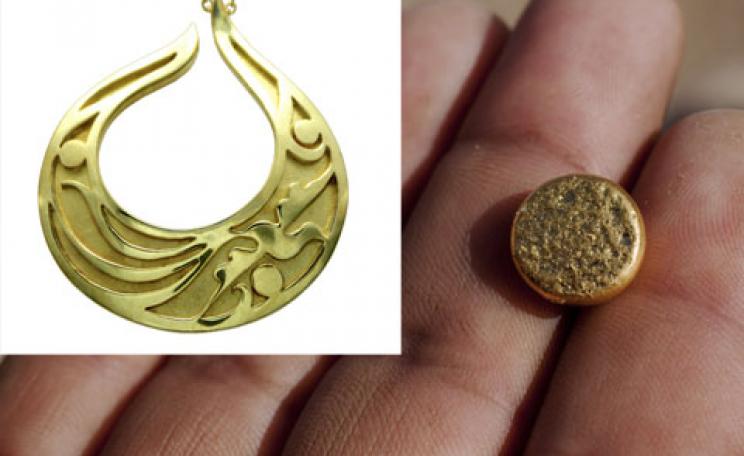In 1980 he discovered an unexplored gold deposit in Palo Ralos. Since then his ‘blessing’ has turned into a curse with the arrival of an international mining company. His community has been forced off their land, their water supplies poisoned with cyanide, and their traditional way of life wrecked. To add insult to injury the profits he is entitled to are still being withheld by the mining company who made him leave his home.
This is just one of the cases revealed in a new exhibition that has opened at London’s Oxo gallery, telling stories of communities suffering because of gold mining and revealing how behind the glamour of gold, the reality can be horrific.
The exhibition is curated by CAFOD, The Catholic Agency for Overseas Development, as part of the ‘Unearth Justice’ campaign which aims to ‘clean up’ the gold industry. Two award-winning photojournalists travelled to the communities that the aid agency has been working with, to document the conditions of those affected by gold-mining. Richard Wainwright travelled to the Democratic Republic of Congo, and Annie Bungeroth documented the stories of people in the Philippines and Honduras.
The stories and pictures they returned with are both visually mesmerising and emotionally striking, leaving the viewer shocked at how such a small element can cause such massive destruction, whether environmentally, financially, physically or emotionally. For example to mine enough for one gold ring creates 18 tonnes (equivalent to two double-decker buses) of waste rock that may leach toxic metals and acid. It is a bitter paradox that mineral-rich developing countries have some of the highest economic growth rates in the world - and the highest poverty rates.
Over 70 per cent of gold is mined in the developing world, and with the recently soaring prices, sites that were previously thought of as unprofitable or too risky to operate in are now being explored. Some companies now operate in conflict zones or in countries with weak governance and high corruption. Other laws to regulate mining are inadequate or simply not implemented, and governments have little capacity or the resources to monitor mining companies. The aid agency CAFOD believes that companies have a responsibility to respect the rights of people and they should eliminate harmful social and environmental impacts wherever they operate.
Not all mines are universally awful, but the exhibition focuses on the Philippines, Honduras and the DRC, countries where CAFOD works and where the impact on communities living around mining is acute. In Honduras there are already two large open cast mines, and civil society groups are campaigning to change the mining laws so that they best reflect the interests of the Honduran people, as well as maintaining the country’s allure to foreign investors.
In the DRC, gold mining companies are scaling up their activities after a devastating conflict, which was in part fuelled by different armed groups seeking to control the goldfields. In this fragile situation, the way that foreign mining companies operate now will have a huge influence over the country’s future development. Conditions are appalling. Examples like mother of seven Christian Gewe, 42, who works all day carrying 30kg bags of rocks out of the mine up a steep slope, and then walking one km for the rocks to be crushed are sadly not unusual.
 The Ituri District in the north east of the Democratic Republic of Congo is home to one of the world's richest goldfields, but its people live in poverty, scraping a meagre living from small-scale gold mining. By Richard Wainwright/CAFOD
The Ituri District in the north east of the Democratic Republic of Congo is home to one of the world's richest goldfields, but its people live in poverty, scraping a meagre living from small-scale gold mining. By Richard Wainwright/CAFOD
The Philippines has a long history of irresponsible mining in the country, during which local communities have seen little benefit of mining on their lands. Photographer Annie Bungeroth shows indigenous people fighting back after seeing their sacred mountain destroyed to make way for a gold mine. Interviews reveal a woman who was forcibly evicted from her land in a midnight raid by company security, having to watch as bulldozers destroyed everything she and her family have lived for.
In some ways, these stories don’t shock – a person in the developing world being exploited by trans-national corporations isn’t news. But after viewing the exhibition, it seems slightly perverse that we can choose to highlight our wealth with something that symbolises poverty and injustice to so many.
Due to the nature of the industry, it’s impossible for consumers to tell where the gold they buy comes from. CAFOD has successfully persuaded seven high-street jewellers in the UK to sign up to ‘12 Golden Rules’, a code of practice for responsible mining, and is encouraging retailers to improve their transparency.
Now attention is being switched to mining companies’ investors. Most people don’t realise that the majority of pension funds invest in mining companies. Therefore anyone with a pension could own part of a mining company and so has a right to have a say in how these companies are run. These investments are collectively managed by fund managers who can have powerful influence over the over mining companies they hold investments with – after all, poor mining practices may not only be damaging to local communities and the environment, but can also make for poor investments. People with pensions are being asked to urge their pension fund managers use their influence and stand up for communities in developing countries whose lives are blighted by irresponsible mining practices. To take part or for more information visit www.cafod.org.uk/unearthjustice
The exhibition reveals terrible practices and horrendous conditions, but rather than demanding an end to mining, CAFOD calls for people most directly affected by mining to be presented with all the information about the costs and benefits of a mine so that they can better challenge governments and companies to eliminate the harmful affects of mining. It also calls for companies to stop the practices that lead to the damage that people and the environment are clearly suffering as demonstrated by the stories and pictures in the exhibition.

It also makes business sense; investing in mining projects that don’t have adequate environmental and social standards exposes investors to financial risk. Adequate environmental and social standards for mining companies shouldn’t be an optional extra.
By Rashmi Mistry, CAFOD Head of Campaigns.




